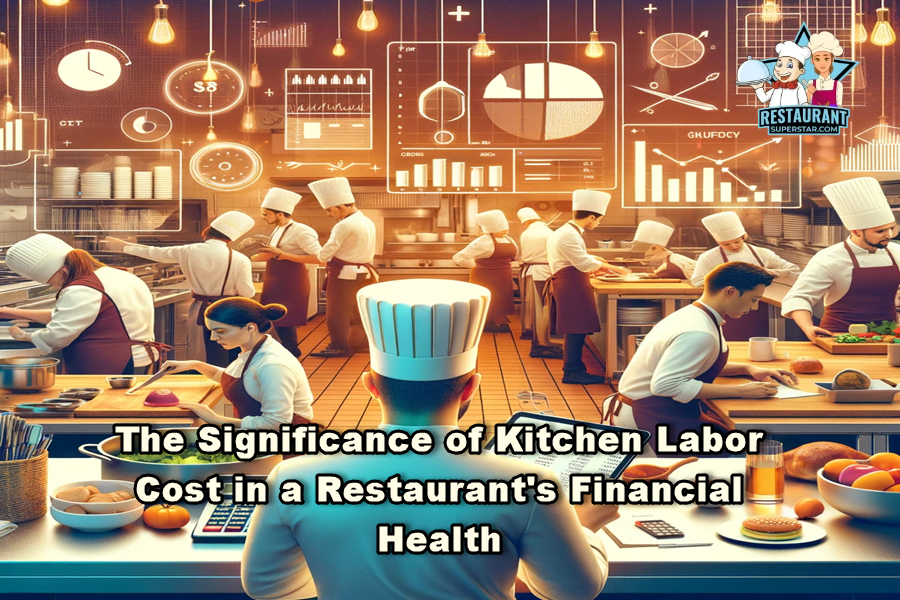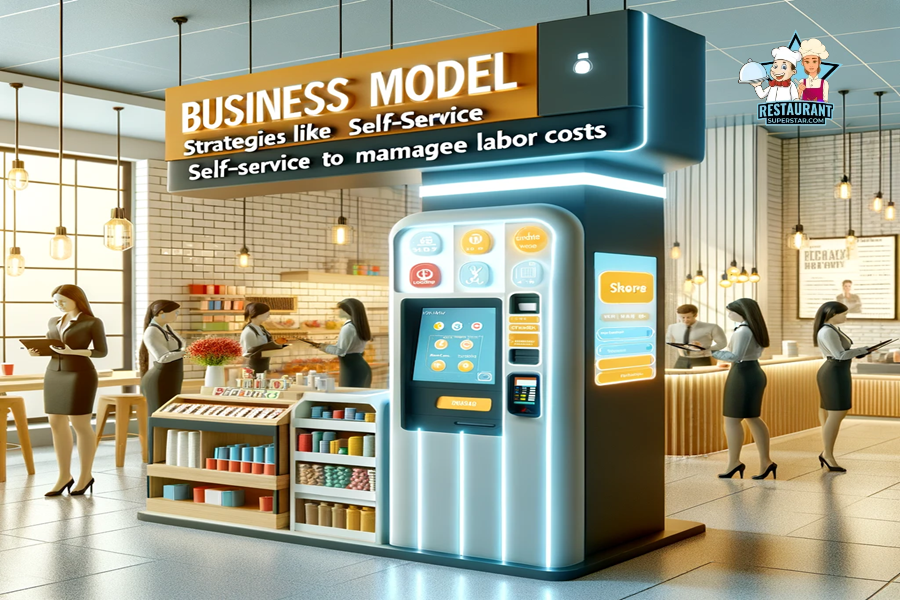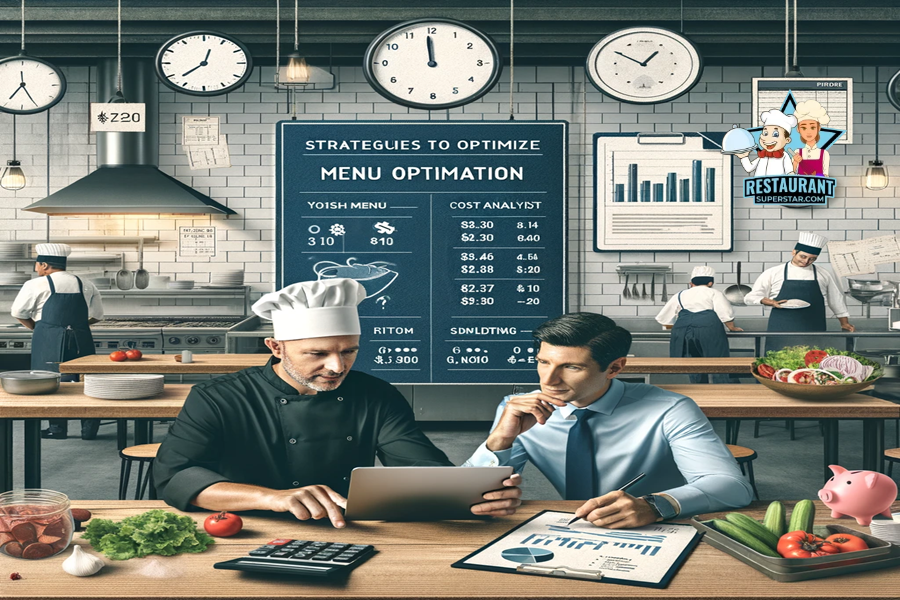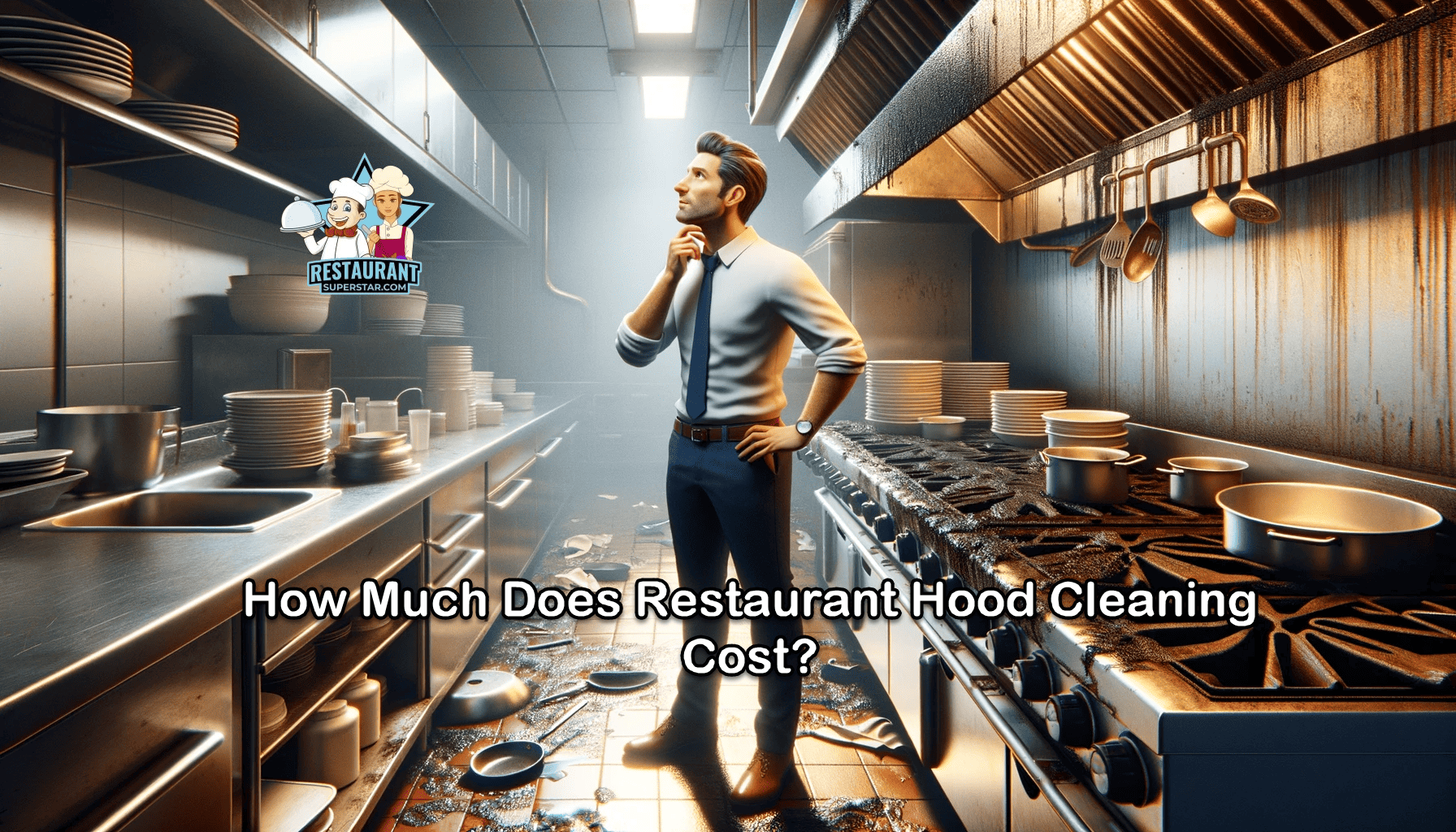What Should Kitchen Labor Cost Be in a Restaurant?
Welcome to the ultimate guide on “What Should Kitchen Labor Cost Be in a Restaurant.” You’ve hit the jackpot if you’re a new restaurant owner, a young chef, or simply seeking in-depth insights into restaurant labor costs.
This article doesn’t just answer your primary question; it delves into the nuances that make managing a restaurant’s finances challenging and fascinating.
What Should Kitchen Labor Cost Be in a Restaurant?
Kitchen labor costs typically range between 20-30% of a restaurant’s gross revenue.
However, this is just the tip of the iceberg. In this article, we unravel the layers behind these numbers. We’ll explore how factors like restaurant type, location, and menu complexity influence these costs.
Plus, we’ll provide strategic insights into optimizing labor costs without compromising quality or staff morale.
Stay tuned as we dive deeper into practical strategies for managing kitchen labor costs, tailored specifically for new restaurateurs and culinary professionals eager to make their mark.
This journey promises enlightening, offering actionable tips and industry secrets to help you run a financially sound and successful culinary venture.
Remember, understanding “What Should Kitchen Labor Cost Be in a Restaurant” is just the beginning. There’s much more to learn; we have all the insights you need here.
Let’s get started!
Understanding Kitchen Labor Cost
Kitchen labor costs refer to the total expenses incurred by a restaurant on its kitchen staff, comprising everyone from the head chef to the dishwashers.
These costs are not limited to hourly or monthly salaries but include additional expenses such as benefits, bonuses, and taxes the employer must cover.
It is crucial to understand kitchen labor costs for various reasons. Firstly, it helps in effective budgeting, enabling smarter decisions related to menu pricing, portion sizes, and the number of employees required for each shift.
Kitchen labor costs are one of the most significant expenses in the restaurant industry, and keeping a close eye on them ensures that the business remains profitable.
Finding the right balance between paying the staff fairly while generating profits is essential.
Calculating kitchen labor costs involves considering everyone who contributes directly or indirectly to kitchen operations. Whether you’re a new or seasoned restaurant, understanding these costs is vital for success.
The following discussion will discuss calculating these costs, which percentages to aim for, and how to maintain balance. Think of it as a recipe for ensuring a financially healthy restaurant.
The Significance of Kitchen Labor Cost in a Restaurant’s Financial Health

As a restaurant owner, you know that labor costs are a significant part of your operating expenses. Managing these costs effectively in the food service industry is crucial for financial stability and success.
Balancing your staffing needs to ensure a smoothly running kitchen and happy customers while avoiding overspending is challenging.
However, if your kitchen labor costs are too high, you may struggle to need help to make a profit, even with substantial sales.
On the other hand, if you cut corners excessively, you risk compromising the quality of your food and service. This could lead to happier customers and, ultimately, a drop in sales.
Pricing strategy is also affected by labor costs. Understanding these costs helps you set the correct prices for your menu items. If you price them too low, you may not cover your expenses; if you price them too high, you could scare away customers.
Efficient staffing and fair wages create a healthy work environment, translating into happy employees, better food, and better service.
A well-managed kitchen labor cost is a win-win situation for everyone involved – your staff, customers, and bank account.
Kitchen labor costs are a vital aspect of restaurant profitability. Understanding and managing these costs is essential for long-term success and sustainability.
Let’s explore how you can optimize these costs for the health and prosperity of your restaurant.
Factors Affecting Kitchen Labor Costs: Restaurant Type
Regarding kitchen labor costs, not all restaurants are created equal. The type of restaurant you run plays a huge role in determining these costs. Let’s break down the differences between quick service, casual dining, and fine dining and see how each impacts your labor budget.
Quick Service Restaurants (QSRs)
- Speed and Simplicity: QSRs, known as fast-food restaurants, prioritize speed and efficiency. The menu items are usually simple to prepare and often pre-made or require minimal cooking.
- Labor Costs: Because of the simpler menu and the assembly line style of service, QSRs generally have lower labor costs. Here, you’re looking at labor costs typically on the lower end of the spectrum, around 20-25% of your revenue.
- Staffing: The staff usually performs specific, repetitive tasks, so you might not need highly skilled chefs, thus keeping wages relatively moderate.
Casual Dining Restaurants
- Balanced Approach: Casual dining balances quick service and fine dining. The menus offer more variety than QSRs but are less complex than fine dining.
- Labor Costs: Here, the labor costs start to inch up a bit, usually between 25% and 30% of revenue. This is because you need a mix of skilled and semi-skilled staff to handle the diverse menu.
- Staffing Flexibility: Casual dining often requires a flexible staff that can handle different tasks, from cooking to possibly interacting with customers, adding to the labor cost.
Fine Dining Restaurants
- High Skill and Quality: Fine dining is all about the experience. This includes high-quality ingredients, elaborate dishes, and exceptional service.
- Labor Costs: Consequently, labor costs in fine dining are typically the highest, often exceeding 30% and reaching 35% or more of revenue. The reasons are clear: you need highly skilled chefs, more staff per customer for personalized service, and, often, a higher wage bracket to attract top talent.
- Specialization and Detailing: Fine dining kitchens are characterized by specialized roles (like sommeliers, sous chefs, and pastry chefs) and a focus on detail, contributing to higher labor costs.
In a nutshell, your restaurant type significantly influences your kitchen labor costs.
Quick service is about efficiency and lower skill levels, casual dining requires a balanced and flexible approach, and fine dining demands high skills and specialization, each impacting labor costs.
Understanding this will help you better plan your budget and strategies for managing these costs effectively.
Location: Impact of Regional Minimum Wage and Employee Benefits on Labor Costs
Location, location, location – it’s not just a real estate mantra; it’s also crucial in determining your restaurant’s labor costs. The region where your restaurant is situated can significantly affect how much you spend on your kitchen staff. This concerns two main factors: regional minimum wage laws and employee benefits regulations.
Let’s dive in.
Regional Minimum Wage Laws
- Varied Wages Across Regions: Minimum wage rates can vary dramatically from one region to another. For instance, what you pay your staff in a big city like New York or San Francisco is likely significantly higher than that in smaller towns or rural areas.
- Impact on Labor Costs: This variation means that if your restaurant is in an area with a high minimum wage, your base labor costs will automatically be higher. You’ll need to factor this into your budgeting and pricing strategies.
- Competitive Wages for Talent: Moreover, in regions with a high cost of living, offering competitive wages above the minimum wage is often necessary to attract and retain skilled staff, further influencing your labor costs.
Employee Benefits Regulations
- Mandatory Benefits: Depending on the location, there may be legal requirements for certain employee benefits like health insurance, paid leave, or retirement plans. These benefits are an integral part of the total compensation package for your employees.
- Voluntary Benefits and Competitive Edge: Besides mandatory benefits, offering additional perks can help attract top talent. Things like culinary training programs, wellness initiatives, or meal discounts can be appealing but will add to your overall labor costs.
- Cost Implications: While providing benefits is undoubtedly good for employee morale and can reduce turnover, it also means higher labor costs. It’s a delicate balance between caring for your team and managing your budget.
Adapting to Local Conditions
- Understanding Local Market: Understanding the economic landscape of your restaurant’s location is essential. This includes adhering to legal requirements and understanding what’s typical or expected in your area.
- Pricing Strategy Alignment: You might need to adjust your menu prices or operational strategies to align with the higher labor costs incurred due to regional factors.
The impact of location on kitchen labor costs in the restaurant business must be balanced.
The interplay of regional minimum wage laws and employee benefits regulations requires careful consideration and strategic planning.
Understanding and adapting to these local factors can better position your restaurant for financial stability and success.
Remember, a well-compensated and satisfied staff is often the secret ingredient to a thriving restaurant.
Business Model: Strategies Like Self-Service to Manage Labor Costs

The business model you choose for your restaurant also plays a pivotal role in managing labor costs.
One innovative approach gaining traction is the implementation of self-service strategies. This modernizes the dining experience and can significantly impact your labor costs.
Let’s look at how this works and other business model considerations.
Self-Service Models
- Technology Integration: Incorporating self-service kiosks or digital ordering systems allows customers to place orders without staff assistance. This tech-forward approach can reduce the need for front-of-house staff.
- Labor Cost Reduction: By shifting some tasks to the customer, you can operate with a leaner staff, particularly during non-peak hours, thereby reducing labor costs.
- Customer Experience: While this might seem impersonal, many customers appreciate the speed and control over their ordering process. It’s a balancing act between customer service and cost efficiency.
Limited Service Models
- Counter Service and Takeout: Another model that reduces labor costs focuses on counter service or a predominantly takeout setup. These models require fewer staff members as table service is less needed.
- Operational Efficiency: This model can streamline operations, making the kitchen the primary focus with less emphasis on full-service dining.
Menu Simplification
- Efficient Kitchen Operations: Simplifying your menu can lead to more efficient kitchen operations. Fewer menu items mean less complexity in preparation, which can reduce the need for highly specialized kitchen staff.
- Inventory Management: A more straightforward menu also aids in inventory management, reducing waste and associated costs, indirectly impacting labor efficiency and costs.
Automated Systems for Repetitive Tasks
- Technology Use in Kitchens: Implementing technology in the kitchen for repetitive or time-consuming tasks can reduce the labor needed. Think of automated dishwashers, food processors, or even advanced cooking equipment.
- Reduction in Man-hours: By automating certain kitchen functions, you can save on person-hours needed for these tasks, effectively controlling labor costs.
Cross-Training Staff
- Versatile Workforce: Training your staff to handle multiple roles within the restaurant can lead to more efficient staffing, especially during lean periods or unexpected rushes.
- Reduced Staffing Needs: Cross-trained staff can switch roles as needed, reducing the overall headcount required without compromising service quality.
Outsourcing Non-Core Activities
- External Vendors for Specific Tasks: Consider outsourcing tasks like cleaning, maintenance, or specific prep work. This can be cost-effective compared to having in-house staff for these roles.
- Focus on Core Activities: Outsourcing allows your team to focus on core activities like cooking and customer service, potentially enhancing efficiency and reducing costs.
Adopting a business model that aligns with self-service or limited-service strategies can be an intelligent move in controlling labor costs.
It’s about finding the right mix of technology, service model, and operational efficiency to match your restaurant’s ethos and customer expectations.
By thinking creatively and embracing modern solutions, you can strike a balance between maintaining quality service and managing labor expenses effectively.
Calculating Kitchen Labor Cost: A Step-by-Step Guide
To effectively manage your restaurant’s finances, you must know how to calculate your kitchen labor cost percentage.
Understanding one of your most significant expenses is more important than simply performing calculations.
Here’s a straightforward guide to help you calculate this key metric:
Gather Your Data
- Total Labor Costs: First, compile all the costs associated with your kitchen staff. This includes wages, salaries, overtime, benefits, and other related expenses.
- Time Period: Choose a specific time for the calculation, like a month or a quarter.
Calculate Total Labor Costs
- Wages and Salaries: Add up all the regular payments to your kitchen staff for the chosen period.
- Additional Expenses: Include extra expenses like overtime pay, bonuses, and benefits (health insurance, retirement contributions, etc.).
Determine Your Total Revenue
- Revenue Figures: You’ll need your total revenue for the period in which you calculated your labor costs. This is your total income from sales before any expenses are deducted.
Calculate the Labor Cost Percentage
- The Formula: Use the formula Labor Cost Percentage=(Total Labor CostsTotal Revenue)×100Labor Cost Percentage=(Total RevenueTotal Labor Costs)×100.
- Example: If your total labor costs for a month are $10,000 and your total revenue for that month is $50,000, then your labor cost percentage is (10,00050,000)×100=20(50,00010,000)×100=20.
Analyze Your Results
- Benchmarking: Compare your percentage with industry standards (typically 20-30% for most restaurants). If you’re above or below this range, it might indicate areas for improvement or adjustment.
- Consistency: Regularly calculate this percentage to monitor trends and make informed decisions.
Consider Seasonal Variations
- Adjust for Seasonality: Remember that your labor costs might fluctuate during different times of the year. Consider calculating this percentage for various seasons to get a more accurate picture.
Use the Data for Decision Making
- Strategic Planning: Use your labor cost percentage as a tool for strategic planning. It can help make staffing, menu pricing, and operational adjustments decisions.
Remember, calculating your kitchen labor cost percentage isn’t a one-time task. It’s an ongoing process that helps you stay on top of your finances and make intelligent, data-driven decisions for your restaurant’s success.
Keep this guide handy, and you’ll be well on your way to mastering this essential aspect of restaurant management.
Example calculation for clarity.
Absolutely; let’s walk through an example calculation to give you a clear picture of how to compute kitchen labor cost percentage. We’ll use hypothetical numbers for a better understanding.
Imagine you own a small restaurant and want to calculate your kitchen labor cost percentage for March.
Total Labor Costs for March
- Wages for Chefs and Cooks: $6,000
- Wages for Dishwashers and Prep Staff: $2,000
- Benefits (like health insurance, retirement contributions): $1,000
- Overtime Pay: $500
So, your Total Labor Costs = $6,000 (chefs/cooks) + $2,000 (dishwashers/prep) + $1,000 (benefits) + $500 (overtime) = $9,500
Total Revenue for March
- Suppose your restaurant made a total revenue of $40,000 in March.
Calculating the Labor Cost Percentage
- Now, apply the formula: Labor Cost Percentage = (Total Labor Costs / Total Revenue) x 100
- Put in the numbers: Labor Cost Percentage = ($9,500 / $40,000) x 100
- Calculate: Labor Cost Percentage = 0.2375 x 100
So, your Labor Cost Percentage for March = 23.75%
What does this mean?
- In this example, for every dollar you earned in March, about 23.75 cents went toward covering kitchen labor costs.
- This percentage is within the typical industry standard of 20-30%, which is a good sign. However, always aim for the lower end of the spectrum to maximize profitability without compromising staff welfare and operational efficiency.
Why is this important?
- Knowing this percentage helps you understand a significant part of your operating expenses.
- It can guide you in making decisions about staffing, menu pricing, or even negotiating with suppliers to improve your profit margins.
Remember, this is a simplified example. You might have more complex factors to consider in real scenarios, but the basic principle remains the same.
Regularly calculating and analyzing your kitchen labor cost percentage is critical in maintaining a healthy and profitable restaurant business.
Strategies to Optimize Kitchen Labor Cost: Menu Optimization

Let’s explore some practical strategies to optimize kitchen labor costs, starting with menu optimization. Designing your menu can significantly impact your kitchen’s efficiency and labor costs. Here’s how:
Using Seasonal Ingredients
- Cost-Effectiveness: Seasonal ingredients are generally more affordable and accessible. You can reduce costs associated with expensive imports or off-season purchases by sourcing locally and seasonally.
- Quality and Efficiency: Seasonal ingredients are often fresher and tastier. This appeals to customers and simplifies cooking, requiring less time and labor to make dishes shine.
Offering Fewer Dishes
- Streamlined Kitchen Operations: A smaller menu means less complexity in the kitchen. This can lead to quicker prep times, faster cooking processes, and a more efficient workflow.
- Reduced Training Time: Training new kitchen staff becomes more accessible and quicker with fewer dishes. This can lead to reduced labor hours spent on training and more focus on productivity.
- Inventory Management: A concise menu simplifies inventory management. Fewer ingredients to track means less time spent on inventory tasks and potential reductions in waste, translating to labor and cost savings.
Menu Engineering
- High-Profit Dishes: Focus on dishes with a higher profit margin. Analyze which items sell well and contribute more to your bottom line. Prioritize these in your menu planning.
- Cost Analysis: Regularly review the cost of ingredients for each dish. If certain items are consistently expensive to produce, consider modifying or removing them from the menu.
Customer Preferences and Trends
- Adapt to Demand: Keep an eye on customer preferences and food trends. Adapting your menu to what’s popular can help attract more customers, increase revenue, and offset labor costs.
- Specials and Limited Offers: Introduce unique dishes for a limited time. This keeps your menu exciting and allows you to test new items without a long-term commitment.
Cross-Utilization of Ingredients
- Versatile Ingredients: Use ingredients that can be utilized in multiple dishes. This reduces the number of ingredients your kitchen needs to handle, streamlining prep work and reducing costs.
By optimizing your menu, you not only create a more efficient and cost-effective kitchen but also enhance the dining experience for your customers.
A well-thought-out menu can be a powerful tool in controlling labor costs while maintaining, or even improving, the quality of your food.
Efficient Staff Scheduling: Using Data for Better Staffing Decisions
Efficient staff scheduling is a cornerstone in optimizing kitchen labor costs. It’s all about having the correct number of hands on deck at the right time. Let’s delve into how you can use data to make smarter staffing decisions:
Analyzing Customer Traffic Patterns
- Data Collection: Collect data on your restaurant’s busiest and slowest times. Look at historical sales data, reservations, and local events that might affect customer flow.
- Schedule Accordingly: Use this data to predict busy periods and schedule more staff during these times. Conversely, you can reduce staff during expected slow periods to save on labor costs.
Leveraging Technology for Scheduling
- Scheduling Software: Various digital tools and software are available to help with scheduling. These tools can analyze data, predict staffing needs, and consider employee availability and preferences.
- Efficiency and Fairness: Technology can lead to more efficient schedules and help avoid issues like understaffing or overstaffing. It also adds a level of fairness and transparency to the scheduling process.
Cross-Training Staff
- Versatile Employees: Train your staff to perform multiple roles. For example, a prep cook might also be trained to handle dishwashing or basic cooking during peak hours.
- Flexibility in Scheduling: Cross-trained employees can fill in gaps as needed, reducing the need for a large staff and allowing for more flexible scheduling.
Considering Part-Time or Flexible Staffing
- Adaptability: Hiring part-time or flexible staff can be beneficial. These employees can be scheduled during peak business hours, providing the necessary labor without the commitment of full-time salaries.
- Seasonal Adjustments: This approach helps handle seasonal variations in customer traffic.
Monitoring and Adjusting Schedules Regularly
- Ongoing Analysis: Regularly review and adjust your schedules based on the latest data and observations. What worked last month might not be optimal this month.
- Employee Feedback: Engage with your staff for feedback on the schedule. They can offer valuable insights from the front line.
Avoiding Burnout
- Employee Well-being: While optimizing schedules, consider the well-being of your staff. Overworking leads to burnout, affecting service quality and increasing turnover rates.
- Balance: Strive for a balance between meeting your labor needs and maintaining a happy, healthy workforce.
Using data to inform your staffing decisions, you optimize your labor costs and ensure that your restaurant operates smoothly and your staff remains motivated and productive.
Efficient staff scheduling is an art that balances business needs with employee satisfaction, leading to a more prosperous and harmonious restaurant environment.
Kitchen Layout and Equipment: Improving Workflow and Efficiency
Optimizing your kitchen’s layout and investing in the right equipment can significantly enhance workflow and efficiency.
This speeds up service and reduces labor costs by enabling your staff to work more effectively. Let’s explore how:
Ergonomic Kitchen Design
- Streamlined Workflow: Design your kitchen layout to minimize unnecessary movement. An ergonomic setup ensures that everything is strategically placed for ease of access and efficiency.
- Work Stations: Organize your kitchen into specific workstations (like prep, cooking, and cleaning areas). This helps to avoid bottlenecks and ensures that staff can work without getting in each other’s way.
High-Efficiency Equipment
- Invest in Quality: Invest in high-quality, durable kitchen equipment that can withstand heavy usage. This includes ovens, stoves, mixers, and dishwashers.
- Speed and Consistency: Modern equipment often comes with features that speed up cooking and prep times while maintaining consistency in food quality.
Energy-Efficient Appliances
- Cost Savings: Energy-efficient appliances may have a higher upfront cost, but they save money in the long run by reducing utility bills.
- Sustainability: They’re also environmentally friendly, which can be a selling point for your restaurant.
Regular Maintenance
- Prevent Downtime: Regular equipment maintenance prevents unexpected breakdowns that can disrupt kitchen operations and increase labor costs through inefficiency.
- Maintenance Schedule: Implement a routine maintenance schedule to keep everything in top working condition.
Technology Integration
- Automated Solutions: Consider integrating technology solutions like automated food processors, programmable ovens, or inventory management systems.
- Reduced Manual Labor: These tools can decrease the amount of manual labor required, allowing staff to focus on tasks that add more value to the customer experience.
Space Utilization
- Maximize Space: Use every inch of your kitchen efficiently. This includes adequate storage solutions to keep the workspace organized and clutter-free.
- Flexible Design: In smaller kitchens, consider equipment and furniture that can be moved or reconfigured to suit different service requirements.
Employee Training and Input
- Proper Training: Ensure your staff is well-trained to efficiently use new equipment and workflows.
- Feedback Loop: Regularly ask for staff input on kitchen layout and equipment. They can provide practical insights into what works well and can be improved.
By focusing on a well-designed kitchen layout and the right equipment, you can create an environment that maximizes efficiency and productivity.
This not only improves the overall operation of your restaurant but can also lead to significant savings in labor costs. A well-organized and equipped kitchen is a key ingredient for a successful and profitable restaurant.
Best Practices for Managing Kitchen Labor Costs
Optimize Staffing
Optimizing staffing in line with customer traffic is essential for managing kitchen labor costs effectively.
Here are some best practices to ensure you have the correct number of staff at the proper times, balancing customer needs with cost efficiency:
Understand Traffic Patterns
- Analyze Peak Times: Use historical data to identify peak hours, days, and seasons. Look at trends over time to understand when your restaurant is busiest.
- Anticipate Fluctuations: Be aware of local events or holidays affecting customer traffic and plan accordingly.
Flexible Staffing Strategies
- Adaptive Scheduling: Implement flexible scheduling where staff hours can be increased or decreased based on real-time demand.
- On-Call Staff: Consider having a pool of on-call staff who can be brought in during unexpected busy periods.
Efficient Rostering
- Shift Planning: Plan shifts carefully to ensure adequate coverage during busy times while avoiding overstaffing during slower periods.
- Cross-Training: Cross-train staff to handle different roles. This provides more flexibility to move staff where they are needed most.
Leverage Technology for Scheduling
- Scheduling Software: Use scheduling software to help predict staffing needs and streamline the scheduling process. These tools can provide insights based on sales data, weather forecasts, and other variables.
- Employee Self-Service: Allow staff to swap shifts or fill in for each other through a digital platform, reducing the management burden.
Regularly Review and Adjust Schedules
- Performance Metrics: Regularly review staffing levels against sales data and adjust schedules to improve efficiency.
- Feedback from Staff: Encourage input from your team. They can offer valuable insights into how staffing levels affect operations.
Manage Overtime Effectively
- Monitor Overtime: Monitor overtime hours, as they can quickly escalate labor costs.
- Overtime Policies: Establish clear policies for overtime approval to control unnecessary additional costs.
Incorporate Staff Well-being
- Avoid Burnout: Ensure that staff are well-rested, which can lead to burnout and turnover. Happy, rested employees are more productive and provide better service.
- Work-Life Balance: Respect your staff’s need for work-life balance. Satisfied employees are more likely to stay long-term, reducing turnover and training costs.
By optimizing your staffing based on customer traffic, you manage your labor costs more effectively and enhance customer service and staff satisfaction.
It’s about finding the right balance between being adequately staffed to meet demand without overspending on labor during quieter times.
Control Wages
Balancing competitive wages with budget constraints is critical to managing kitchen labor costs. It’s about attracting and retaining quality staff while keeping an eye on your bottom line. Here’s how you can strike this balance:
Market Research on Wage Standards
- Stay Informed: Regularly research industry wage standards in your area. Know what your competitors are paying their staff.
- Competitive Wages: Set wages that are competitive to attract skilled staff. Being above average is an excellent strategy to attract the best talent.
Performance-Based Incentives
- Reward Efficiency: Implement a performance-based incentive system. This can include bonuses for meeting specific targets, like reducing waste or improving service speed.
- Align Incentives with Business Goals: Ensure these incentives encourage behaviors aligning with your business objectives.
Regular Wage Reviews
- Scheduled Assessments: Conduct regular reviews of your wage structure. This helps in keeping up with inflation and cost of living changes.
- Transparent Communication: Be transparent with your staff about when and how wages are reviewed and adjusted.
Flexible Staffing Options
- Part-Time or Seasonal Staff: Utilize part-time or seasonal staff to manage high-traffic periods without committing to full-time wages year-round.
- Internships and Apprenticeships: Consider internships or apprenticeships, which can be a cost-effective way to bring in new talent at a lower salary, with the potential for future growth.
Effective Labor Deployment
- Skill Matching: Ensure staff are deployed in roles matching their skill levels. Avoid overpaying for tasks that can be effectively performed by less experienced staff.
- Task Optimization: Streamline tasks to reduce the time and skill required, allowing for more wage allocation flexibility.
Training and Development
- Invest in Training: Provide training to improve efficiency and skill sets. Well-trained staff can handle a broader range of tasks, which can justify a higher wage.
- Career Development Paths: Offer clear paths for career development, which can be a compelling reason for staff to stay and grow with your restaurant, even at competitive wages.
Legal Compliance and Ethics
- Adhere to Minimum Wage Laws: Always comply with minimum wage laws and regulations.
- Fair Pay Practices: Maintain ethical pay practices. This not only avoids legal complications but also fosters a positive work environment.
Balancing wages with budget constraints requires strategic planning, understanding market trends, and fostering a positive work environment. Competitive salaries, a good working environment, and growth opportunities can lead to a loyal and efficient workforce, ultimately contributing to your restaurant’s overall success and sustainability.
Improve Efficiency
Improving efficiency in your kitchen is a powerful strategy for reducing labor costs. Streamlining processes saves time and minimizes waste, which is crucial for a profitable restaurant operation.
Here’s how you can enhance efficiency in your kitchen:
Process Evaluation and Optimization
- Workflow Analysis: Regularly assess the workflow in your kitchen. Look for bottlenecks or repetitive processes that can be streamlined.
- Continuous Improvement: Adopt a continuous improvement mindset, where you always look for ways to make processes more efficient.
Implementing Standard Operating Procedures (SOPs)
- Develop SOPs: Create standard operating procedures for all kitchen tasks, from prep work to cleaning. This ensures consistency and efficiency.
- Training on SOPs: Ensure all staff are trained on these procedures, ensuring everyone works as effectively as possible.
Waste Reduction
- Track Waste: Monitor and track food waste to identify areas for improvement. This can include over-preparation, spoilage, or errors during cooking.
- Waste Minimization Strategies: Implement strategies to minimize waste, like using trimmings for stocks or optimizing portion sizes.
Prep Time Reduction
- Prep Scheduling: Schedule prep work during off-peak hours to use staff time better.
- Prep Efficiency: Invest in equipment that speeds up prep work, like high-quality food processors or efficient peelers and slicers.
Use of Technology
- Kitchen Tech Tools: Utilize technology, like kitchen display systems, to improve order accuracy and reduce time spent on communication.
- Inventory Management Software: Implement software for inventory management to decrease the time spent on stock control and ordering.
Cross-Training Staff
- Versatile Skill Sets: Cross-train your kitchen staff so they can perform multiple roles. This flexibility allows smoother operations, especially during unexpected rushes or staff shortages.
- Team Efficiency: Promote teamwork where staff can support each other during peak times, improving overall kitchen efficiency.
Regular Equipment Maintenance
- Prevent Breakdowns: Keep all kitchen equipment well-maintained to prevent breakdowns that can disrupt kitchen operations and cause delays.
Employee Feedback and Engagement
- Staff Suggestions: Encourage staff to provide suggestions for process improvements. They are your frontline workers and can offer valuable insights.
- Engage and Motivate: Engaged employees are more likely to be efficient. Foster a positive work environment where staff feel valued and part of the team.
You can significantly reduce prep time and labor costs by improving efficiency through streamlined processes, waste reduction, and effective use of technology. Efficient operations boost profitability and improve the working environment and customer satisfaction.
Monitor Performance
Regularly monitoring and analyzing your kitchen’s labor costs is essential for identifying opportunities for improvement and ensuring long-term financial health.
Here’s how to effectively track and use this data:
Establish Key Performance Indicators (KPIs)
- Identify Metrics: Determine which key performance indicators are most relevant for your kitchen operations. Common KPIs include labor cost percentage, staff productivity, and overtime rates.
- Set Targets: Establish clear targets for each KPI. These should be realistic and aligned with your overall business goals.
Regular Financial Reviews
- Schedule Reviews: Regularly reviews your financial statements, focusing on labor costs. Monthly or quarterly reviews are typical.
- Compare Against Revenue: Always consider labor costs about revenue. This helps in understanding the bigger picture of how labor impacts profitability.
Utilize Financial Software and Tools
- Accounting Software: Implement accounting or payroll software that can help track labor costs automatically and provide insightful reports.
- Data Analytics: Use data analytics tools to investigate labor cost trends and patterns.
Employee Productivity Analysis
- Track Productivity: Monitor the productivity of your staff. Are there times when staff are idle? Are there tasks that take longer than they should?
- Optimize Schedules: Use this information to optimize work schedules and task allocations.
Ongoing Process Evaluation
- Continuous Process Improvement: Regularly evaluate kitchen processes and procedures to identify areas for increased efficiency.
- Innovation and Adaptation: Be open to adopting new methods or technologies that could enhance productivity and reduce labor costs.
Regular Feedback and Communication with Staff
- Staff Meetings: Meet regularly with your kitchen team to discuss performance and gather feedback.
- Encourage Ideas: Create an environment where staff feel comfortable suggesting improvements. The best efficiency ideas often come from those directly involved in the day-to-day operations.
Benchmark Against Industry Standards
- Industry Comparisons: Compare your labor cost percentages with industry averages or similar businesses in your area. This can provide valuable context for your numbers.
- Best Practices Research: Stay informed about best practices in the industry and consider implementing relevant strategies in your kitchen.
Action Plan for Improvement
- Develop Action Plans: Based on your analysis, develop action plans for areas needing improvement. This could involve staff training, process changes, or investing in new equipment.
- Monitor Impact: Track the impact of these changes on your labor costs and adjust your strategies accordingly.
Regularly monitoring and analyzing kitchen labor costs is not just about cutting costs; it’s about optimizing resource use for maximum efficiency and profitability.
By staying informed and proactive, you can ensure that your kitchen operations support your restaurant’s overall success and sustainability.
Conclusion
Let’s reinforce some key takeaways as we wrap up this comprehensive guide on managing kitchen labor costs. Regular labor cost analysis is not just a good practice; it’s an essential tool in the arsenal of any successful restaurant owner or manager.
This ongoing process provides invaluable insights into your business, helping you make informed decisions that balance financial health with quality service.
It’s crucial to remember that there is no one-size-fits-all solution for managing kitchen labor costs.
Every restaurant is unique, with its own set of challenges and opportunities. The type of restaurant, its location, menu complexity, customer preferences, and even the skill level of your staff – all these factors play a role in determining your optimal labor cost management strategy.
Therefore, understanding the specific needs of your restaurant is vital. What works for a quick-service restaurant might not suit a fine-dining establishment.
Similarly, effective strategies in a metropolitan area might not apply to a rural setting. It’s about tailoring your approach to fit your restaurant’s unique context.
Regularly monitoring your labor costs, staying adaptable to changes, and being open to new strategies are vital to maintaining a profitable and thriving restaurant.
Invest time in understanding your labor cost dynamics, and don’t hesitate to adjust your strategies as your business evolves. By doing so, you’ll keep your finances healthy and create a positive, productive working environment for your staff.
Remember, the goal is to find that sweet spot where efficiency meets quality – ensuring your kitchen runs smoothly, your staff is motivated, and your guests leave satisfied.
With the right approach to managing kitchen labor costs, your restaurant can enjoy lasting success and a reputation for excellence. Cheers to your culinary adventure and the exciting journey of restaurant management.
Jeff Smith is a Restaurant Consultant with over 20 years of hospitality experience ranging from server to owner and general manager. He focuses on Restaurant POS technology as well as restaurant marketing. Check out our world-famous restaurant resources page for a comprehensive offering of hand-picked resources and tools to help your business. You can also check out some of our other restaurant business articles.



